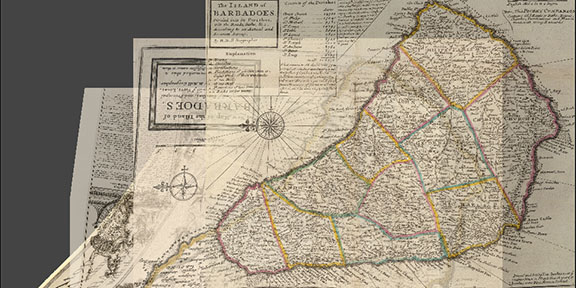IMAGE OF THE WEEK
 A digital comparison of historical maps of Barbados by Peter Koby
A digital comparison of historical maps of Barbados by Peter Koby
During the colonial phase of Barbados’ sugar industry, a number of maps were made of the island conveying a remarkable amount of cultural and economic information. Differing cartographic choices and varying levels of accuracy provide an intriguing challenge in comparing these maps. Learn more by attending this week’s Coffee Hour.
GOOD NEWS
- The book proposal of E.-K. Kim (with Raja Sengupta and Liliana Perez) to publish accepted GIScience workshop full & short papers has been accepted to the Springer “Advances in Geographic Information Sciences” series, scheduled to be published summer 2017.
- Nate Frey’s paper “Equity in the Distribution of Urban Environmental Amenities: The Case of Washington, D.C.” has been accepted for publication in Urban Geography.
- Guido Cervone received a grant from the NSF for “EarthCube Building Blocks: Collaborative Proposal: The Power of Many: Ensemble Toolkit for Earth Sciences.”
- Updated 2016-17 student and faculty/staff parking maps (work done by the Gould Center) are now available for pickup at the Parking Office and online at www.parking.psu.edu.
- Travis Young is one of 14 Penn State National Science Foundation (NSF) Graduate Research Fellowship Program (GRFP) recipients for the 2016-17 academic year.
- Mikael Hiestand is a 2016–17 recipient of the Anne C. Wilson Graduate Fellowship
- Zongjun Li, a geography major from Guangzhou, China, is featured in an article about EMS International Culture Night.
NEWS
Coffee Hour on September 23
Department of Geography graduate student lightening talks
Ethan Davis
Is there enough existing agricultural land to feed and fuel the world?
Carolyn Fish
Point Symbols
Yooinn Hong
Home but Not Tame: Wild plants in home gardens tells a tale of agricultural modernization impacts in Jeju, South Korea.
Peter Koby
Temporal Data from a Digital Comparison of Historical Maps of Barbados
- 3:30 to 5:00 p.m.
- Refreshments are offered in 319 Walker Building at 3:30 p.m.
- The lecture begins in 112 Walker Building at 4:00 p.m.
- Coffee Hour To Go Webcast
- Next week: Jared Oyler “Topoclimate data products: empirical modeling of climate variability at locally relevant spatiotemporal scales”
Andrew Carleton quoted in AccuWeather news story on supra-glacial lakes
Why beautiful blue lakes forming on East Antarctica have scientists worried
Beautiful, blue lakes are beginning to form atop of East Antarctica ice sheets, but despite their breathtaking aura, these lakes are sparking concerns among scientists. Supraglacial lakes form during the warmer summer months when temperatures tend to rise above freezing. The higher air temperature at the surface causes the snow over the glacier to melt and form these ponds. However, these dazzling meltwater ponds may pose serious threats for glaciers.
No ordinary classroom
Imagine studying and learning where your classroom has no walls. It is the expansive Groot Winterhoek Wilderness where you sleep out under the stars and observe ancient rock paintings by the San and Khoi people. It is the Karoo National Park, a biodiversity conservation area, where you consider the effects of fracking. It is Nelson Mandela’s prison cell on Robben Island where you hear stories from those who knew him personally and gain access not available to the general public.
Penn State welcomes three new ethics core faculty members
This fall the Rock Ethics Institute at Penn State welcomes the second group of ethics core faculty members recruited to expand the University’s national leadership in ethics research and ethical literacy. The faculty members, C. Daryl Cameron (psychology), Joshua F. J. Inwood (geography), and Alan R. Wagner (aerospace rngineering), are part of the University’s transformative initiative to position itself at the intersection of its research strengths and the world’s major ethical conversations.
RECENTLY (OR SOON TO BE) PUBLISHED
“Measuring burstiness for finite event sequences”
By E.-K. Kim and Hang-Hyun Jo
In Physical Review E (Vol.94, No.3
URL: http://link.aps.org/doi/10.1103/PhysRevE.94.032311
DOI: 10.1103/PhysRevE.94.032311
Characterizing inhomogeneous temporal patterns in natural and social phenomena is important to understand underlying mechanisms behind such complex systems and, hence, even to predict and control them. Temporal inhomogeneities in event sequences have been described in terms of bursts that are rapidly occurring events in short time periods alternating with long inactive periods.
“DOG” OF THE WEEK
Last week’s animal companion was Kasey. The dog is part of the Kloehr family. There were no correct guesses about her identity.
Each week we feature a mystery photo of an animal companion. Any animal companion can be the dog of the week. Have fun guessing which human cares for this creature and learning about the members of our community.
Send your photos and/or your guesses to geography@psu.edu. The identity of the mystery animal will be revealed the following week.
